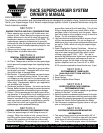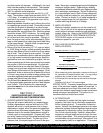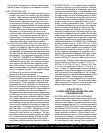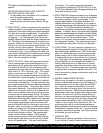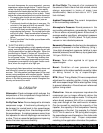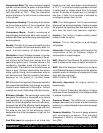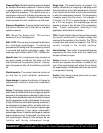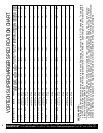
© 2000 Vortech Engineering, Inc. All Rights Reserved. International Copyrights Secured. 25FEB00 V 2.0 DRAFT P/N: 008515
Questions?
Please contact: Vortech Engineering, Inc. • 1650 Pacific Ave., Channel Islands, CA 93033-9901
Phone: (805) 247-0226 • Fax: (805) 247-0669 • Website: vortechsuperchargers.com • Hours: M-F 8AM - 4:30PM (PST)
too much horsepower for your suspension), you may
experience a supercharger failure. Traction loss can
cause the engine and supercharger to be rapidly
accelerated and decelerated as well as overspun,
resulting in a premature failure of one or both. Listed
below are some precautions that must be observed:
• The engine rpm should not and does not need to
exceed 4500 rpm in the burnout box (use rev
limiter).
• The burnout should only be done in one gear. Do
not start in first gear and shift into second. Start
in second gear and hold a steady rpm.
• You need to slowly accelerate and decelerate the
engine during the burnout. Do not stab the throttle
and let off quick. Rapid acceleration followed by
rapid deceleration may cause a supercharger
failure.
• Do not "modulate" the throttle up and down while
heating the tires.
8. THROTTLE BODY LOCATION
On road racing applications or high speed endurance
racing, mounting the throttle body before the air inlet
of the supercharger has distinct benefits. When the
throttle body is closed it "chokes off" the airflow to
the supercharger, thus virtually eliminating the need
for air bypass valves. This mounting location also
provides cooler discharge temperatures and lower
horsepower consumption during part throttle condi-
tions, when the engine is at a high rpm.
The previously listed precautions have been obser-ved
and utilized by numerous racing teams with great
success. This information has been tested in the most
severe racing conditions with excellent results. Vortech
superchargers performance and durability have been
proven in the field at numerous events throughout the
country and around the world.
GLOSSARY
Aftercooler: A heat exchanger which reduces the
temperature of the compressed charge before it
enters the combustion chamber.
Air By-Pass Valve: Device designed to eliminate
compressor surge. It functions by allowing air to
be dumped (or routed back to the supercharger
inlet on MAF engines) from the discharge side of
the supercharger. It employs pressure sensor lines
that operate an internal diaphragm connected to
a valve. This is an essential performance improving
device that also improves durability.
Air Fuel Ratio: The amount of air compared to
the amount of fuel in the air fuel ratio mixture, almost
always expressed in terms of mass (see
stoichiometric). Ideal air fuel ratio is 14.7:1 (see
fuel rich/lean).
Ambient Temperature: The current temperature
of the surrounding outside air.
Atmospheric Pressure: Normal pressure in the
surrounding atmosphere, generated by the weight
of the air above us pressing down. At sea level, in
average weather conditions, atmospheric pressure
is approximately 100 kPa (about 14.5 psi) above
vacuum or zero absolute pressure.
Barometric Pressure: Another term for atmospheric
pressure. Expressed in inches of Mercury (in.Hg.).
How high atmospheric pressure (relative to zero
absolute pressure) forces Mercury up a glass tube.
14.5 psi= 29.92 in.Hg.
Blower: Term often applied to all types of
superchargers.
Boost: Condition of over pressure (above
atmospheric in the intake manifold) caused by intake
air being forced in by a supercharger.
BTM: (Boost Timing Master) Drivers compartment
adjustment for retarding ignition timing. Included
with some supercharger kits to retard ignition timing
to prevent detonation. A boost/vacuum referenced
ignition timing retard.
Choke Line: Area on compressor map where the
compressor can no longer efficiently deliver the
amount of airflow the engine needs. It is the point
where boost pressure falls off on a compressor
map, even though air flow continues to increase.
Can be caused by reaching the capacity of the
impeller, the capacity of the compressor housing
passageway, or the inlet. For example, if a Vortech
V-5 D-Trim is used on a 700 hp big block engine,
the supercharger would operate on the choke side
of the compressor map. Proper compressor
matching to the application eliminates this problem.
5



